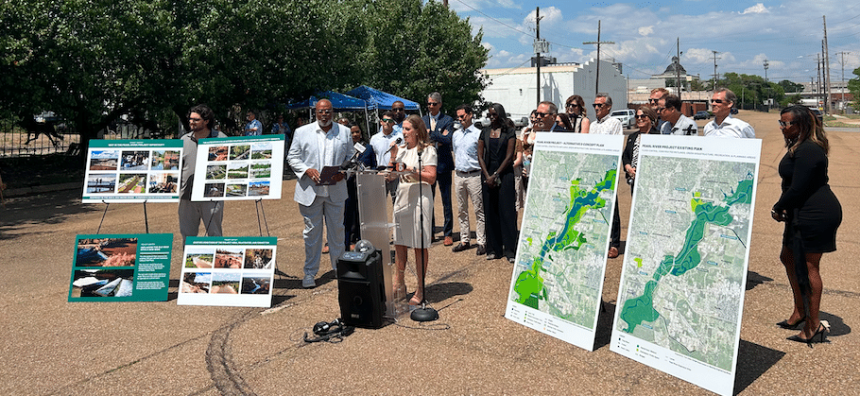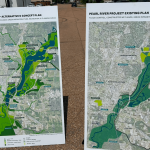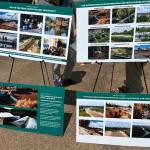A group of individuals representing educational, community, private sector, and non-profit institutions throughout Mississippi’s capital city joined forces to show their support for a plan developed by the U.S. Army Corps of Engineers to reduce flood risks from the Pearl River.
On Wednesday, the group, known as the Pearl River Revitalization Coalition, gathered in downtown Jackson and weighed in on how the proposal could reduce flood concerns, allow central Mississippians to utilize the Pearl River at a much greater degree than currently possible, and spur economic development in the region.
“This is a once-in-a-generation opportunity to help revitalize and improve the lives of every citizen in Jackson,” Mississippi Children’s Museum Executive Director Emily Hoff said. “This project combines flood control with community improvement and clean water for our city. It connects Jackson back to the Pearl River and makes it not only safe and sustainable but ultimately a beautiful gathering place for our community with the potential for riverfront parks and trails that we can all enjoy.”
The coalition strongly supports the compromise Alternative D plan as the only option that combines flood protection and community benefits while simultaneously allowing for a modern, environmentally superior water plant in south Jackson, as expressed in public comments by JXN Water.
The Alternative D plan entails removing the 100-year-old weir at LeFleur’s Bluff Park and constructing a new weir further south down Interstate 20 to create a “Lake Surface Area” of 1,706 acres. A weir is a small barrier, or low-rise dam, built across a river or stream to control and raise the water level on the upstream side.
Members of the coalition believe this could contribute to the creation of a water treatment facility near the new location of the weir and could directly help communities in south Jackson, where the neighborhoods suffered the most from the lack of a reliable, clean water supply — which was amplified during the city’s infamous crisis in 2022. The new weir would also feature a fish passage to allow aquatic species to pass through unharmed.
The community access features of the Alternative D project will connect the river to the many other trails and park improvements planned or underway throughout the city. Officials contend that this could help bring the community together for recreational activities and other events which could aid in reversing Jackson’s ongoing population decline.
“We’ve seen cities across the country embrace their urban rivers. When this happens, it leads to an explosion of positive quality of life improvements for our community as well as economic opportunities,” said Rickey Thigpen, President and CEO of Visit Jackson. “We want that for our city. We believe that is doable for Jackson, and we are ready to work together to make it happen.”
The Pearl River Revitalization Coalition is comprised of a large number of Jackson city leaders, educational institutions, community groups, cultural institutions, businesses, and residents who are committed to this project as a way to change the trajectory of Jackson. The coalition includes:
- Jackson Mayor Chokwe Antar Lumumba
- Hinds County Supervisor Robert Graham
- Representatives from
- University of Mississippi Medical Center
- Jackson State University
- Tougaloo College
- Millsaps College
- Belhaven University the
- Mississippi Museum of Art
- Ergon
- C Spire
Pointing to how similar waterfront projects have yielded positive results in cities like Denver, Colorado, and Tulsa, Oklahoma, the coalition is optimistic that Jackson could see a resurgence in economic prosperity and community engagement. However, opponents of the plan, particularly residents along the Pearl River in south Mississippi and Louisiana, argue that the proposal is a real estate ploy disguised as a plan to mitigate flooding in the region.
“Make no mistake, this coalition is going to fight just as hard as our opposition is fighting. They don’t want to see a shovel go in the ground,” Jeff Rent said. “We think we have an opportunity here not just for flood control, not just creating new economic development and investment opportunities, but we have the opportunity here to create something that is going to be used for generations.”










